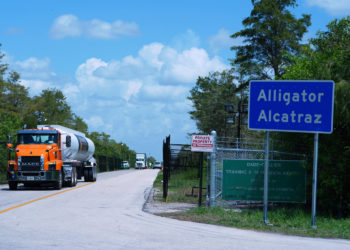When clothing manufacturers first made high visibility jackets, the purpose was to make the laborers who wore them as visible as possible. But brightly colored safety clothes are now so ubiquitous that they often have the opposite effect, so that the wearer blends in, even as the bold colors catch the eye.
That can make them a key part of the criminal’s tool kit.
On Sunday, when thieves broke into the Louvre in Paris and stole $102 million worth of jewelry, two of them wore neon-colored safety vests. Other criminals have donned the vests to rob jewelry stores and airports, commit murders and steal cars; daub buildings in graffiti, and strip buildings of valuable metal wiring.
Experts say the neon items help criminals operate in plain sight.
“High-vis clothing carries a strange paradox,” said Caroline Stevenson, the program director of cultural and historical studies at the London College of Fashion. “It’s meant to make the wearable visible in industrial or hazardous spaces, yet often it renders the wearer socially invisible,” she said.
Arthur Brand, a Dutch art crime expert, said that, for criminals, dressing in work wear was “the oldest trick in the book.”
If you are dressed as “a police officer, construction worker or maybe a priest,” Brand said, “people think you’re fine.”
Craig Jackson, a professor of occupational health psychology at Birmingham City University in England, said that high-visibility safety jackets had become such a ubiquitous symbol of authority — like a clipboard or a reporter’s microphone — that they were like “a cloak of invisibility.”
In Paris, the vests are worn by construction workers, emergency service workers and cyclists, and all drivers are legally required to carry one in their vehicle for safety reasons. The clothing item was also the symbol of the “Yellow Vest” protest movement that swept across France starting in late 2018.
Jackson said that social class played a role in how the public reacted to people wearing the vests. “If you see a gang of guys wearing high-visibility jackets, you may assume they’re working class, and so a nice middle-class individual visiting a museum might not feel comfortable challenging them,” he said.
That “embarrassment factor” helps criminals, Jackson said, as does the wide availability of the neon vests, which makes it hard for the police to trace suspects based on their clothing.
Stevenson, of the London College of Fashion, said that workers began wearing high-visibility clothing in the mid-20th century after chemical companies developed fluorescent dyes and reflective stripes for traffic signs. Clothing firms used those technologies to create garments for laborers who had previously worn brightly colored sashes or dressed in light colors to ensure they were seen.
In the 1960s, Scottish railway workers were early adopters of neon jackets, Stevenson said. (The jackets were orange, she added.) By the 1990s, the garments were commonplace and often mandated by health and safety regulations.
In 2015, when a gang stole about $30 million worth of jewels, gold and cash from a safe deposit company in London, one of the thieves was wearing a fluorescent jacket with the word “Gas” on the back.
Although the Louvre thieves wore bright yellow vests, other art thieves have worn different uniforms. In 1990, two men dressed as police officers to rob the Isabella Stewart Gardner Museum in Boston. They walked off with 13 works, including a Vermeer and three Rembrandts, estimated to be worth $500 million — one of the most notorious art thefts in history.
Brand, the Dutch art crime expert, said that in the Netherlands some criminals had recently dressed as police officers to gain access to art collectors’ homes. Once inside, Brand said, the fake officer would claim to have intelligence about a planned burglary and suggest that it would be best if the police stored any valuable paintings at a police station. At least one collector had handed art over, Brand said.
Police uniforms are more elaborate disguises than high-visibility jackets, but Jackson, the psychology professor, said there were ways to make the vests more difficult for criminals to use. He suggested adding a QR code that could be scanned — even by members of the public — to show whether the wearer has the authority to be on-site.
Still, he said, that wouldn’t help in most cases. After all, he added, “if someone’s wearing one, we just don’t notice them.”
Alex Marshall is a Times reporter covering European culture. He is based in London.
The post For Robbers Like the Louvre Thieves, Bright Vests Actually Help Them Hide appeared first on New York Times.




